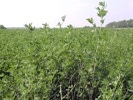March 22, 2010

The Natural Resources Conservation Service is offering a special Cover Crop Initiative statewide through the Environmental Quality Incentives Program.
The deadline for submitting an application for Fiscal Year 2010 funding consideration is Friday, April 9. This special initiative is designed to help increase soil quality and provide an additional source for grazing among other benefits.
"The intent of this cover crop initiative is to encourage producers to be proactive in improving their soil quality," says Rick Bednarek, NRCS Soil Quality Specialist. Benefits of cover crops include increased soil organic matter; reduced wind and water erosion; manage excess nutrients within the soil profile; reduce compaction and increase infiltration; increase soil biological diversity; manage salinity; weed and disease suppression; provides additional forage; and to increase wildlife habitat.
"Improving soil quality is just one of the benefits producers may see from planting a cover crop," says Bednarek. "Cover crops provide an opportunity for producers to extend the grazing season and provide a rest period for pasture and rangeland. A cover crop planted after small grain harvest can provide high quality forage late into the fall. In addition to late season forage, it also can provide early canopy and residue cycling characteristics. And, other cover crop mixtures provide a substantial amount of forage dry matter production."
Payments for implementing a cover crop through this initiative may be up to three years with annual payment capped at $3,200 or $4,800 for historically underserved applicants. All applications will be ranked with the Cover Crop Initiative Ranking. The cover crops must be planted in late summer or early fall months of 2010.
Fall grazing of forage will be allowed; however the grazing period will be minimal to ensure at least a five-inch stubble height remains. Through the ranking process, priority will be given to applications where the cover crop mixture including a legume will be no-tilled into standing small grain stubble, and the following annual crop will be no-tilled into the undisturbed cover crop residue.
Applications or additional information about the cover crop initiative is available from your local USDA Service Center. For more information about cover crops go to www.sd.nrcs.usda.gov/technical/CoverCrops.html.
Source: NRCS
You May Also Like




